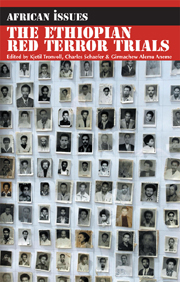Book contents
- Frontmatter
- Contents
- Notes on Contributors
- Preface
- Acknowledgements
- Abbreviations
- Glossary of Amharic Phrases
- 1 The ‘Red Terror’ Trials
- 2 The History of the Red Terror
- 3 The Rights of the Accused
- 4 The Role of the Special Prosecutor's Office
- 5 The Red Terror Trials versus Traditions of Restorative Justice in Ethiopia
- 6 A Quest for Justice or the Construction of Political Legitimacy?
- 7 Building State & Nation
- 8 Beyond the Red Terror Trials
- 9 Concluding the Main Red Terror Trial
- Index
2 - The History of the Red Terror
Contexts & Consequences
Published online by Cambridge University Press: 12 September 2012
- Frontmatter
- Contents
- Notes on Contributors
- Preface
- Acknowledgements
- Abbreviations
- Glossary of Amharic Phrases
- 1 The ‘Red Terror’ Trials
- 2 The History of the Red Terror
- 3 The Rights of the Accused
- 4 The Role of the Special Prosecutor's Office
- 5 The Red Terror Trials versus Traditions of Restorative Justice in Ethiopia
- 6 A Quest for Justice or the Construction of Political Legitimacy?
- 7 Building State & Nation
- 8 Beyond the Red Terror Trials
- 9 Concluding the Main Red Terror Trial
- Index
Summary
Revolutionary Reigns of Terror occur within the post-revolutionary period or crisis when revolutionary regimes seek to hang on to political power in the face of opposing forces contending for that power.
(O'Kane 1991: 9)… revolution presents two contrasting faces: the one glorious and appealing; the other violent and terrifying.
(Mayer 2000: 3)Introduction
The contrasting faces of the Ethiopian Revolution are all too apparent. As in other classical revolutions, notably the French and the Russian, the euphoria that attended the initial outbreak was followed by anguish and remorse. Indeed, seen retrospectively, the latter sentiment clearly overshadows the former. Nothing illustrates this more graphically than the fact that the protagonists of the Ethiopian Revolution were imprisoned, facing charges of genocide and mass murder. The best and the brightest perished in that process, particularly in the two fateful years between 1976 and 1978. The gap left behind by this calamity is akin to the generation gap that attended the Graziani Massacre of February 1937 during fascist Italy's occupation of Ethiopia, when some of the most agile and promising minds were targeted for liquidation. But neither moral indignation nor legal prosecution can adequately resolve this national disaster. There is a need to put what looked like a monstrous aberration in perspective, to contextualize it both globally and nationally. This chapter attempts to do that. Needless to say, explanation should in no way be construed as justification.
- Type
- Chapter
- Information
- The Ethiopian Red Terror TrialsTransitional Justice Challenged, pp. 17 - 32Publisher: Boydell & BrewerPrint publication year: 2009



